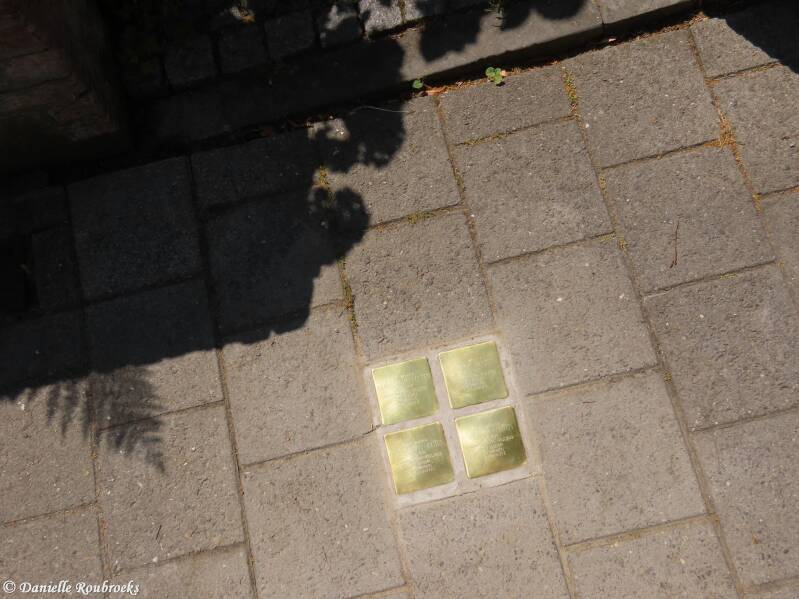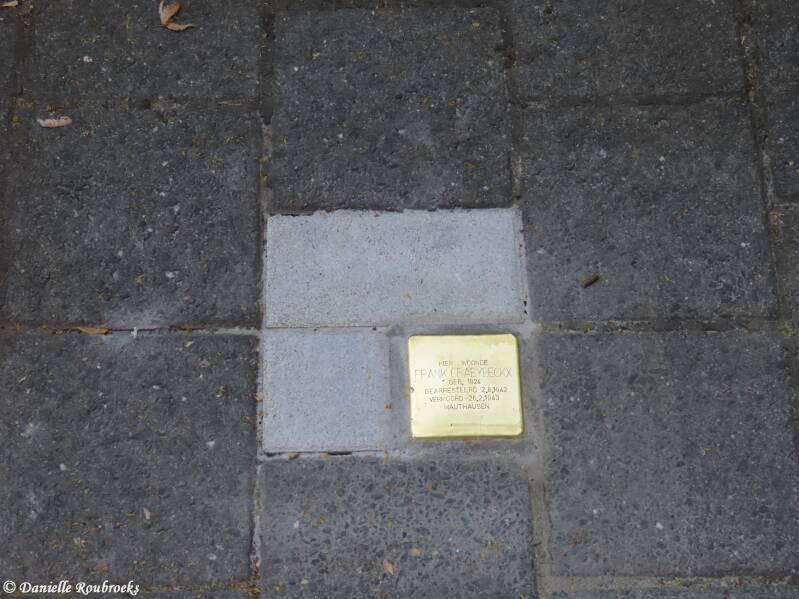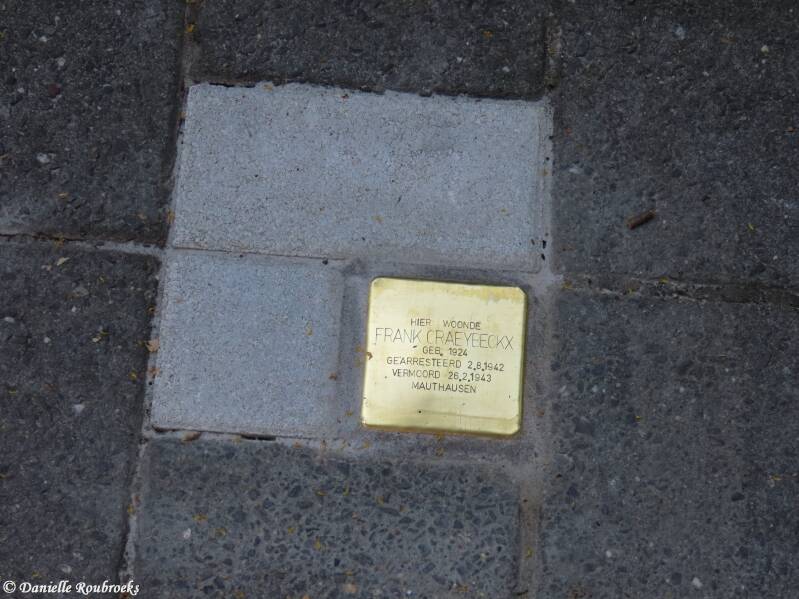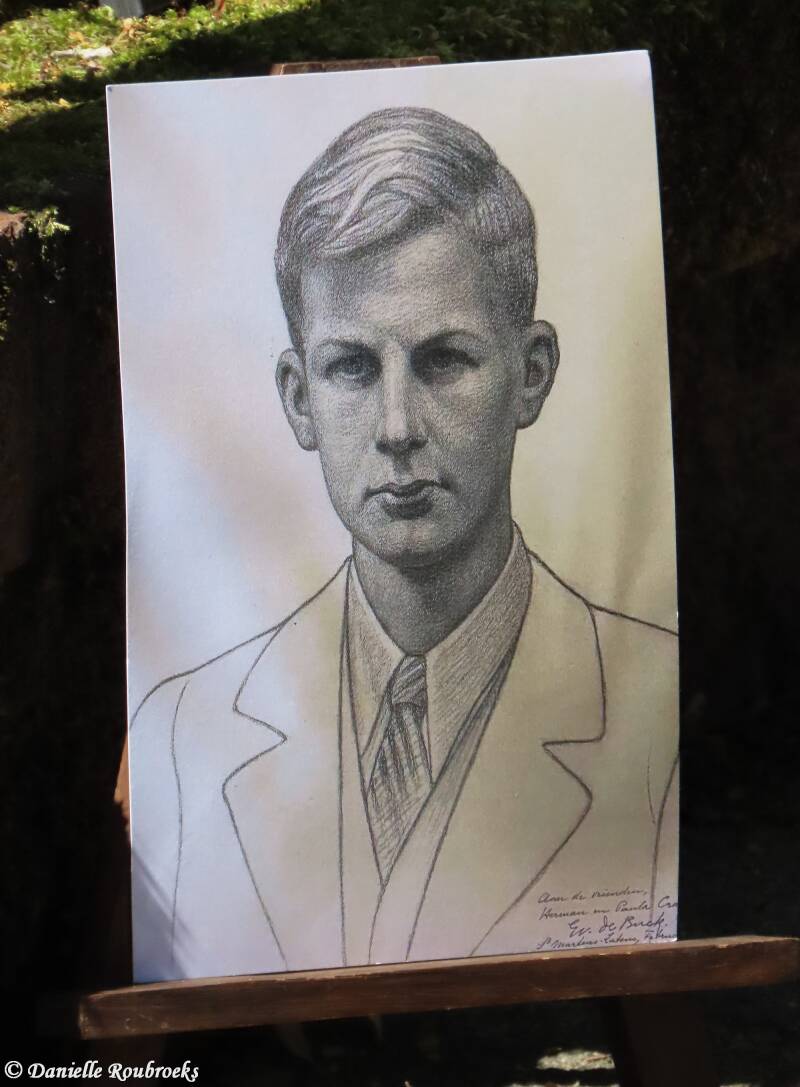Mortsel - Stolpersteine
Information: Wikipedia
A Stolperstein literally "stumbling stone", metaphorically a "stumbling block" is a sett-size, 10 by 10 centimetres (3.9 in × 3.9 in) concrete cube bearing a brass plate inscribed with the name and life dates of victims of Nazi extermination or persecution.
The Stolpersteine project, initiated by the German artist Gunter Demnig in 1992, aims to commemorate individuals at exactly the last place of residency—or, sometimes, work—which was freely chosen by the person before he or she fell victim to Nazi terror, euthanasia, eugenics, was deported to a concentration or extermination camp, or escaped persecution by emigration or suicide. As of 29 March 2018, over 67,000 Stolpersteine have been laid in 22 countries, making the Stolpersteine project the world's largest decentralized memorial.
The majority of Stolpersteine commemorate Jewish victims of the Holocaust. Others have been placed for Sinti and Romani people (then also called "gypsies"), homosexuals, the physically or mentally disabled, Jehovah's Witnesses, black people, members of the Communist Party, the Social Democratic Party, and the anti-Nazi Resistance, the Christian opposition (both Protestants and Catholics), and Freemasons, along with International Brigade soldiers in the Spanish Civil War, military deserters, conscientious objectors, escape helpers, capitulators, "habitual criminals", looters, and others charged with treason, military disobedience, or undermining the Nazi military, as well as Allied soldiers.
List of Stolpersteine in the city of Mortsel
Ridder van Ranstlei 49: ELIAZAR VAN HOUTEN
HELENA MENIST
LEA VAN HOUTEN
HERMAN VAN HOUTEN
Ridder van Ranstlei 73: FRANK CRAEYBECKX
Ridder van Ranstlei 83: KAREL HENDRIK DERKZEN VAN ANGEREN
Ridder van Ranstlei 49
hier woonde
ELIAZAR VAN HOUTEN
geb. 1887
gedeporteerd 29.8.1942
uit Dossin
vermoord
Auschwitz
Ridder van Ranstlei 49
here lived
ELIAZAR VAN HOUTEN
born 1887
deported 29.8.1942
from Dossin
murdered
Auschwitz
Ridder van Ranstlei 49
hier woonde
HELENA MENIST
geb. 1889
gedeporteerd 29.8.1942
uit Dossin
vermoord
Auschwitz
Ridder van Ranstlei 49
here lived
HELENA MENIST
born 1889
deported 29.8.1942
from Dossin
murdered
Auschwitz
Ridder van Ranstlei 49
hier woonde
LEA VAN HOUTEN
geb. 1928
gedeporteerd 29.8.1942
uit Dossin
vermoord
Auschwitz
Ridder van Ranstlei 49
here lived
LEA VAN HOUTEN
born 1928
deported 29.8.1942
from Dossin
murdered
Auschwitz
Ridder van Ranstlei 49
hier woonde
HERMAN VAN HOUTEN
geb. 1918
gedeporteerd 31.10.1942
uit Dossin
vermoord
Auschwitz
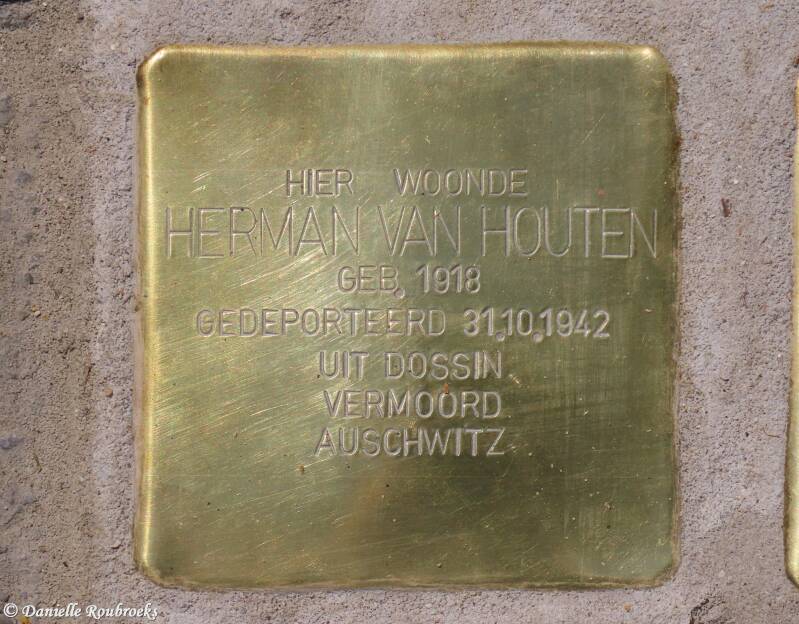
Ridder van Ranstlei 49
here lived
HERMAN VAN HOUTEN
born 1918
deported 31.10.1942
from Dossin
murdered
Auschwitz
At house number 49 lie the stumbling blocks of the Jewish Van Houtven-Menist family. Eliasar, Helena, and their son Herman came to live in Mortsel from the Netherlands in 1919, where their daughter Lea was born in 1924.
But as Jews, they essentially had no chance when World War II broke out. Eliasar, Helena, and Lea arrived in Auschwitz from the Dossin Barracks in August 1942 on the sixth transport.
“Son Herman ended up as a forced laborer in camps in northern France. He, too, was eventually deported. Nothing is known about their subsequent fate. In March 1950, following a court ruling, a civil servant wrote in the population registers after their names that they had died in Auschwitz,” says Bruno Gastmans of the Mortsel Historical Society.
After the liberation, their home was requisitioned to house English citizens.
Ridder van Ranstlei 73
hier woode
FRANK CRAEYBECKX
geb. 1924
gearresteerd 2.8.1942
vermoord 26.2.1943
Mauthausen
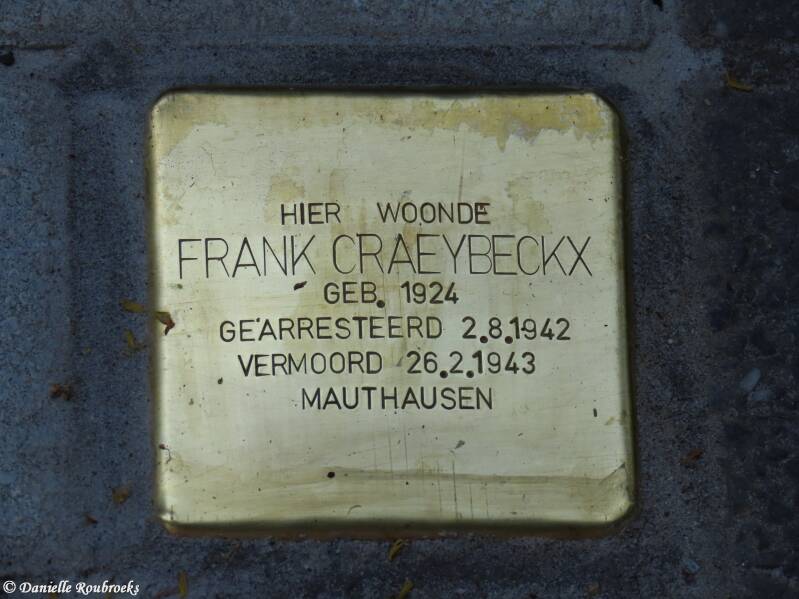
Ridder van Ranstlei 73
here lived
FRANK CRAEYBECKX
born 1924
arrested 2.8.1942
murdered 26.2.1942
Mauthausen
Frank Craeybeckx is one of the people who received a stumbling block. "He was primarily active in various resistance newspapers and provided false papers for people who had to go into hiding," says Jasper Van Steenbergen. Craeybeckx was his grandmother's brother. "At some point, he was arrested and taken to Fort Breendonk. Ultimately, he was sent to the camp in Mauthausen, where he died."
Frank Craeybeckx, nephew of former Antwerp mayor Lode Craeybeckx, was arrested by the German police at house number 73 at the age of 18. His cousin Veronica Joris and second cousin Jasper Van Steenbergen have been researching his story in recent years. "Frank developed a strong sense of justice very early on. At sixteen, he and his cousin Jan founded a cell of the communist Revolutionary People's Youth of Flanders from the Berchem grammar school. He wrote and distributed anti-German propaganda, provided false papers to people in hiding, and recruited new members," Jasper and Veronica explain.
On August 2, 1942, he was arrested in the Ridder Van Ranstlei. His parents were unaware of his resistance activities. Jasper gathered from diaries that they continued to hope for his return until after 1945. "But he had already died on February 26, 1943, in the Mauthausen camp. A fellow prisoner later told him that he had received Frank's coat after Frank had told him he was going to die anyway," Jasper adds.
Ridder van Ranstlei 83
hier woonde
KAREL HENDRIK
DERKZEN
VAN ANGEREN
geb. 1903
gearresteerd 14.4.1942
onthoofd 25.11.1943
gevangenis Klingelpütz
Keulen
Ridder van Ranstlei 83
here lived
KAREL HENDRIK
DERKZEN
VAN ANGEREN
born 1903
arrested 14.4.1942
beheaded 25.11.1943
prison Klingelpütz
Cologne
Karel Henri Derkzen Van Angeren lived at number 83 on April 14, 1942. The Dutchman was arrested there on suspicion of espionage.
Until the Dutch army laid down its arms in 1940, he was a soldier defending Zeeland. He had extensive contacts with the Dutch resistance and took over the espionage network of family member Tony Derkzen when he was forced to flee.
On September 25, 1943, Karel was sentenced to death in Berlin for espionage. On November 20, he was sent to Klingelpütz Prison in Cologne, where he was executed.







